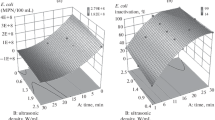Abstract
This work focused primarily upon the effects of ultrasonic pretreatment of both single frequency and dual frequency ultrasonic on the characteristics of sewage sludge disintegration. Quantifications of individual single frequency ultrasonic effects, as well as those of combined dual frequency ultrasonic were determined. This study also investigated and discussed the effects of ultrasonic power density and ultrasonic time. The reported results showed that the sludge solubilization rates increased as the ultrasonic time and ultrasonic power density increased. In terms of the degree of disintegration, the SCOD/TCOD ratio, the SCOD extraction rates, and the solubilization rates, dual-frequency ultrasonic at 28+40 kHz was more effective than single-frequency ultrasonic at 28 kHz or 40 kHz. Sewage treatment plants facing problems with the treatment and disposal of sludge can benefit significantly from the application of dual frequency ultrasonic to the process of sludge pretreatment.
Similar content being viewed by others
References
Chu, C. P., Lee, D. J., Chang, B. V., You, C. S., and Tay, J. H. (2002). “Weak ultrasonic pretreatment on anaerobic digestion of flocculated activated biosolids.” Water Research, Vol. 36, No. 11, pp. 2681–2688.
Harrison, S. T. L. (1991). “Bacterial cell disruption: a key unit operation in the recovery of intracellular products.” Biotechnology, Vol. 9, No. 2, pp. 217–240.
Kunz, P. and Wagner, S. (1994). “Results and outlooks of investigation of sewage sludge Disintegration -Ergebnisse und Perspektiven aus Untersuchungen zur Klärschlammdesintegration-, awt·abwassertechnik, Heft 1.
Li, Y. Y. and Noike, T. (1992). “Upgrading of anaerobic digestion of waste activated sludge by thermal pre-treatment.” Water Science and Technology, Vol. 26, No. 3/4, pp. 857–866.
Mukherjee, S. R. and Levine, A. D. (1992). “Chemical solubilization of particulate organics as a pretreatment approach.” Water Science and Technology, Vol. 26, No. 9–11, pp. 2289–2292.
Müller, J., Lehne, G., Schwedes, J., Battenberg, S., Naveke, R., Kopp, J., Dichtl, N., Scheminski, A., Krull, R., and Hempel, D. C. (1998). “Disintegration of sewage sludge and influence on anaerobic digestion.” Water Science and Technology, Vol. 38, Nos. 8–9, pp. 425–433.
Nickel, K. and Neis, U. (2007). “Ultrasonic disintegration of biosolids for improved biodegradation.” Ultrasonics Sonochemistry, Vol. 14, No. 4, pp. 450–455.
Penaud, V., Delgenès, J. P., and Moletta, R. (1999). “Thermo-chemical pretreatment of a microbial biomass: influence of sodium hydroxide addition on solubilization and anaerobic biodegradability.” Enzyme and Microbial Technology, Vol. 25, Nos. 3–5, pp. 258–263.
Servant, G., Laborde, J. L., Hita, A., Caltagirone, J. P., and Gérard, A. (2003). “On the interaction between ultrasound waves and bubble clouds in mono- and dual-frequency sonoreactors.” Ultrasonics Sonochemistry, Vol. 10, No. 6, pp. 347–355.
Sivakumar, M., Tatake, P. A., Aniruddha, B., and Pandit, A. B. (2002). “Kinetics of p-nitrophenol degradation: effect of reaction conditions and cavitational parameters for a multiple frequency system.” Chemical Engineering Journal, Vol. 85, Nos. 2–3, pp. 327–338.
Stuckey, D. C. and McCarty, P. L. (1984). “The effect of thermal pretreatment on the anaerobic biodegradability and toxicity of waste activated sludge.” Water Research, Vol. 18, No. 11, pp. 1343–1353.
Swamy, K. M. and Narayana, K. L. (2001). “Intensification of leaching process by dual-frequency ultrasound.” Ultrasonics Sonochemistry, Vol. 8, No. 4, pp. 341–346.
Tiehm, A., Nickel, K., and Neis, U. (1997). “The use of ultrasound to accelerate the anaerobic digestion of sewage sludge.” Water Science and Technology, Vol. 36, No. 11, pp. 121–128.
Tiehm, A., Nickel, K., Zellhorn, M., and Neis, U. (2001). “Ultrasonic waste activated sludge disintegration for improving anaerobic stabilization.” Water Research, Vol. 35, No. 8, pp. 2003–2009.
Yu, G. H., He, P. J, Shao, L. M., and Zhu, Y. S. (2008). “Extracellular proteins, polysaccharides and enzymes impact on sludge aerobic digestion after ultrasonic pre-treatment.” Water Research, Vol. 42, Nos. 8–9, pp. 1925–1934.
Author information
Authors and Affiliations
Corresponding author
Rights and permissions
About this article
Cite this article
Jung, Y., Ko, H., Jung, B. et al. Application of ultrasonic system for enhanced sewage sludge disintegration: A comparative study of single- and dual- frequency. KSCE J Civ Eng 15, 793–797 (2011). https://doi.org/10.1007/s12205-011-0832-6
Received:
Revised:
Accepted:
Published:
Issue Date:
DOI: https://doi.org/10.1007/s12205-011-0832-6




